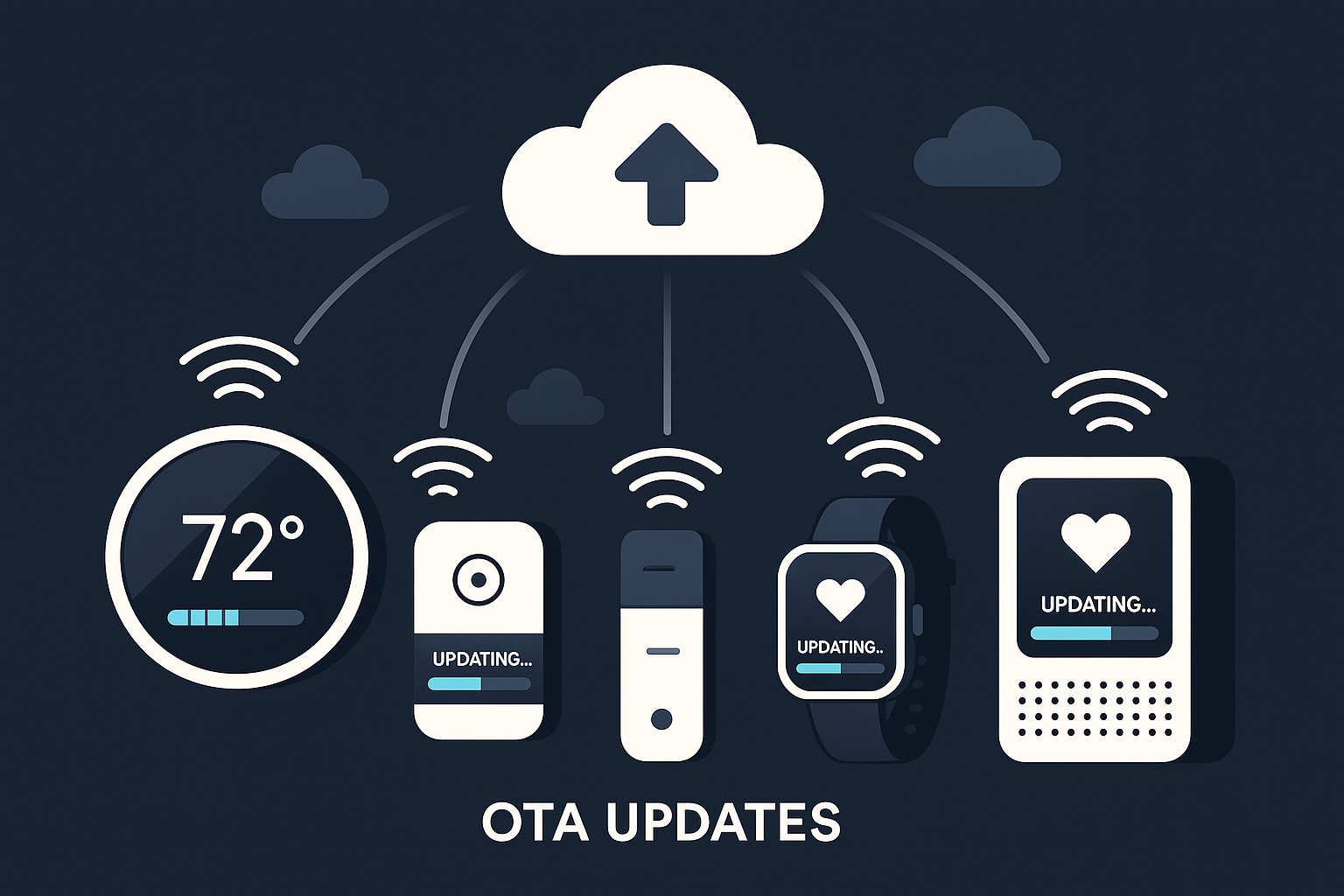3 Simple Methods to Implement OTA in IoT Devices
Learn 3 proven OTA implementation methods for IoT devices: full firmware, delta updates, and modular approaches. Secure, scalable solutions with practical examples.

The Internet of Things landscape continues to expand rapidly, with over 17 billion connected IoT devices currently deployed worldwide and projections reaching 29 billion by 2030. As this ecosystem grows, managing firmware updates for distributed devices becomes increasingly complex. Traditional manual updates requiring physical access to each device are no longer feasible for large-scale deployments.
Over-the-air (OTA) updates have emerged as the cornerstone of modern IoT device management, enabling remote firmware delivery through wireless networks. This technology allows manufacturers to push security patches, bug fixes, and feature enhancements to devices without costly on-site visits. Whether you’re managing smart home devices, industrial sensors, or autonomous vehicles, implementing robust OTA functionality is essential for maintaining device security and performance.
However, choosing the right OTA implementation method can significantly impact your deployment’s success. Different approaches offer varying benefits in terms of bandwidth efficiency, update speed, and system complexity. Understanding these methods and their trade-offs enables you to make informed decisions that align with your specific device capabilities and operational requirements.
This comprehensive guide explores three proven OTA implementation strategies that have become industry standards: full firmware updates, delta updates, and modular updates. Each method addresses different use cases and constraints, from bandwidth-limited environments to complex multi-component systems requiring granular control.
Understanding OTA Updates in IoT
Over-the-air updates represent a fundamental shift from traditional firmware management approaches. Instead of requiring physical connections via USB or JTAG interfaces, OTA technology leverages existing wireless connectivity to deliver software updates remotely. This wireless delivery method has become indispensable for IoT device management, particularly as devices are deployed in remote or hard-to-reach locations.
The OTA update process involves several key components working together seamlessly. An update server stores and manages firmware versions, while devices periodically check for available updates through secure communication channels. When updates are available, devices download, verify, and install new firmware automatically or with minimal user intervention.
Firmware over-the-air (FOTA) updates specifically target the low-level software that directly interacts with device hardware. This includes bootloaders, device drivers, and core system components that control basic device operations. FOTA updates are particularly critical for addressing security vulnerabilities and ensuring devices maintain compatibility with evolving communication protocols.
Modern OTA implementations incorporate robust security measures to protect against unauthorized modifications. Cryptographic signing ensures only trusted firmware reaches devices, while encrypted communication channels protect update packages during transmission. These security features are essential for preventing malicious actors from compromising device fleets through fake or tampered updates.
The benefits of implementing OTA capabilities extend beyond convenience. Organizations report significant cost savings by eliminating truck rolls and reducing manual intervention requirements. Additionally, OTA updates enable rapid response to security threats, allowing manufacturers to patch vulnerabilities across entire device fleets within hours rather than months.
Method 1: Full Firmware OTA Updates
Full firmware OTA updates represent the most straightforward approach to remote device management. This method involves completely replacing the existing firmware image with a new version, essentially performing a comprehensive system refresh. The process begins when the update server makes a complete firmware image available, and target devices download the entire package for installation.
How Full Firmware Updates Work
The full firmware update process follows a structured sequence that ensures reliable delivery and installation. Initially, devices query the update server to check for newer firmware versions by comparing version numbers or timestamps. When an update is available, the device downloads the complete firmware image, which typically ranges from several hundred kilobytes to multiple megabytes depending on device complexity.
Once downloaded, the device performs integrity verification using cryptographic hash functions like SHA-256 to ensure the firmware hasn’t been corrupted during transmission. Digital signature verification confirms the update’s authenticity, preventing installation of unauthorized firmware. If verification succeeds, the device stores the new firmware in a designated flash memory partition before initiating the update process.
The actual firmware installation involves the bootloader switching to the new firmware image and marking it as active. Many implementations use A/B partition schemes where the device maintains two firmware slots, allowing it to boot from the previous version if the new firmware fails during initial startup.
Advantages of Full Firmware Updates
Full firmware OTA updates offer several compelling advantages that make them suitable for many IoT deployment scenarios. The primary benefit is implementation simplicity – developers don’t need to manage complex dependency tracking or incremental patching systems. This straightforward approach reduces development time and minimizes the potential for update-related bugs.
Version control becomes significantly easier with full firmware updates since each deployment contains a complete, known-good system state. Organizations can maintain clear version histories and easily rollback to any previous firmware version if issues arise. This approach also eliminates concerns about partial update failures leaving devices in inconsistent states.
Full firmware updates work exceptionally well for devices with reliable, high-bandwidth connectivity. When network constraints aren’t limiting factors, the additional data transfer overhead becomes negligible compared to the operational benefits. The method also suits development environments where teams prefer comprehensive testing of complete firmware images rather than individual patches.
Disadvantages and Limitations
Despite their simplicity, full firmware updates present notable limitations that may restrict their applicability in certain scenarios. The most significant drawback is bandwidth consumption – transmitting complete firmware images requires substantially more data than alternative approaches. For devices operating on cellular networks or in bandwidth-constrained environments, this overhead translates to increased operational costs.
Battery-powered IoT devices face additional challenges with full firmware updates. The extended download and installation times can significantly drain device batteries, potentially causing update failures or reducing operational lifespan. Devices in remote locations with intermittent connectivity may struggle to complete large downloads within available connection windows.
The update process duration also increases proportionally with firmware size. Larger images require more time to download, verify, and install, creating longer windows where devices remain vulnerable to interruption. Network instability during extended download periods can cause update failures, requiring complete restart of the process.
Best Use Cases
Full firmware OTA updates excel in specific deployment scenarios where their advantages outweigh the limitations. High-bandwidth environments with reliable Wi-Fi connectivity represent ideal conditions, particularly for smart home devices or enterprise IoT systems with dedicated network infrastructure. Devices that primarily operate on AC power can accommodate the extended update times without battery concerns.
Small-scale deployments with fewer than 1,000 devices often benefit from full firmware updates due to their simplicity and reduced development complexity. Organizations prioritizing development speed over bandwidth efficiency frequently choose this approach for initial product launches, transitioning to more sophisticated methods as scale requirements increase.
Critical safety applications sometimes mandate full firmware updates to ensure complete system verification. Medical devices, automotive systems, and industrial safety equipment often require comprehensive validation of entire firmware images rather than incremental patches that might introduce subtle integration issues.
Method 2: Delta OTA Updates
Delta OTA updates represent a sophisticated approach that dramatically reduces bandwidth requirements by transmitting only the differences between firmware versions. This method leverages binary differential algorithms to create compact patches containing just the modifications needed to transform the current firmware into the target version.
Understanding Delta Update Technology
The foundation of delta updates lies in advanced differential algorithms that analyze binary files to identify changes between versions. Popular tools like BSDiff, detools, and HDiffPatch generate optimized patches by comparing old and new firmware images at the byte level. These algorithms employ techniques like longest common subsequence matching and compression to minimize patch sizes.
Delta patch generation occurs on the server side during the build process. Development teams maintain firmware version histories, allowing the system to generate patches between any two versions. This capability enables devices to update from multiple source versions to the latest release, providing flexibility for deployments with mixed firmware versions.
The patch application process requires devices to have sufficient storage for both the current firmware and the incoming delta patch. Bootloaders or specialized update agents handle the patching operation, applying changes to create the new firmware image. Advanced implementations can perform in-place patching to minimize storage requirements, though this approach increases complexity and risk.
Technical Implementation Details
Implementing delta OTA updates requires careful consideration of device hardware capabilities and system architecture. Devices must include patch application engines capable of processing binary diffs and handling error conditions gracefully. These engines typically integrate with the bootloader or run as privileged applications with direct flash memory access.
Storage management becomes critical in delta update implementations. Devices need temporary storage for incoming patches plus working space for the patching operation. Some implementations use dual-bank flash architectures where patches are applied to an inactive bank before switching, while others employ streaming patch application to minimize storage overhead.
Error handling and recovery mechanisms require special attention in delta updates. Unlike full firmware updates where failures simply prevent installation, delta patching failures can potentially corrupt the existing firmware. Robust implementations include integrity checkpoints throughout the patching process and maintain verified backup copies for recovery scenarios.
Compression techniques further optimize delta patches for transmission. Modern implementations combine differential algorithms with context-aware compression like LZ4 or Brotli to achieve remarkable size reductions. Some specialized algorithms like HDiffPatch specifically target firmware binaries, achieving compression ratios exceeding 90% in typical scenarios.
Performance Benefits
Delta OTA updates deliver substantial performance improvements across multiple dimensions compared to full firmware approaches. Bandwidth reduction represents the most significant benefit, with typical delta patches requiring 5-20% of the original firmware size for minor updates. Security patches and bug fixes often result in sub-1% patch sizes, enabling rapid deployment even over low-bandwidth connections.
Update time reduction follows naturally from smaller patch sizes. Devices can download and apply delta patches in minutes rather than hours, minimizing service disruption and reducing vulnerability windows. This speed advantage becomes particularly valuable for critical security updates that need rapid deployment across large device fleets.
Battery life optimization emerges as another key benefit for power-constrained IoT devices. Reduced transmission time directly translates to lower power consumption, extending operational periods between battery replacements. Field studies demonstrate 70-90% reduction in update-related power consumption compared to full firmware approaches.
Network cost optimization provides significant operational savings for cellular-connected devices. With mobile data costs often dominating operational expenses, delta updates can reduce monthly connectivity costs by substantial margins. Organizations managing thousands of cellular devices report savings of tens of thousands of dollars annually through delta update adoption.
Implementation Challenges
While delta OTA updates offer compelling benefits, implementation complexity increases significantly compared to full firmware approaches. Algorithm selection requires careful evaluation of trade-offs between patch size, generation time, and application complexity. Different algorithms excel in different scenarios, necessitating thorough testing and optimization for specific firmware characteristics.
Version management complexity grows exponentially with delta updates. Organizations must maintain comprehensive version matrices to generate patches between any two firmware versions devices might be running. This complexity increases storage requirements and computational overhead for patch generation systems.
Device storage constraints can limit delta update applicability. While patches are smaller than full firmware, devices still need sufficient temporary storage for patch application. Highly constrained devices with minimal flash memory may not accommodate delta patching operations, forcing fallback to full firmware updates.
Patch application reliability requires robust error handling and recovery mechanisms. Unlike full firmware updates where verification occurs before installation, delta patching involves modifying existing firmware, creating opportunities for corruption. Implementing reliable recovery requires additional storage and complexity that may not be feasible on all devices.
Optimal Implementation Scenarios
Delta OTA updates prove most valuable in scenarios where bandwidth constraints significantly impact operational costs or update feasibility. Cellular-connected devices operating on metered data plans benefit enormously from reduced transmission requirements. Remote monitoring systems, asset trackers, and distributed sensor networks represent prime candidates for delta update implementation.
Battery-powered devices with infrequent charging opportunities gain substantial value from delta updates’ reduced power consumption. Smart city sensors, environmental monitoring equipment, and agricultural IoT devices often operate for months between service intervals, making power-efficient updates critical for operational success.
Large-scale deployments with thousands or millions of devices can achieve significant cost savings through delta updates. Even modest per-device savings multiply dramatically across large fleets, justifying the additional implementation complexity. Organizations managing substantial IoT device fleets frequently prioritize delta updates for economic reasons.
Bandwidth-constrained environments where network capacity limits concurrent update capabilities benefit from delta approaches. Industrial facilities with limited internet connectivity, remote installations with satellite links, and developing regions with restricted bandwidth infrastructure all favor delta updates for practical deployment feasibility.
Method 3: Modular OTA Updates
Modular OTA updates represent the most sophisticated approach to IoT firmware management, enabling independent updates of individual system components. This method treats firmware as a collection of discrete modules – such as communication stacks, sensor drivers, application logic, and security components – each capable of independent versioning and updating.
Modular Architecture Fundamentals
Modular firmware architecture requires careful system design from the outset, with clear separation between different functional components. Each module operates within defined boundaries with standardized interfaces for inter-module communication. This architectural approach enables targeted updates to specific functionality without affecting the entire system.
Module isolation ensures that updates to one component don’t inadvertently impact others. Sophisticated implementations use hardware memory protection or virtualization techniques to enforce module boundaries. This isolation becomes critical for system stability and enables confident deployment of updates to specific subsystems.
Dependency management forms a crucial aspect of modular update systems. Modules often depend on specific versions of other components, requiring the update system to track and verify compatibility relationships. Advanced implementations include dependency resolution engines that automatically ensure compatible module combinations during updates.
Version control complexity increases significantly in modular systems where each component maintains independent versioning. Update systems must track multiple version dimensions simultaneously and ensure coherent system states. Some implementations use semantic versioning schemes that encode compatibility information directly into version numbers.
Component-Based Update Process
The modular update process begins with the update system analyzing current module versions against available updates. Rather than treating the system as a monolithic unit, the process evaluates each module independently to determine update requirements. This analysis considers both security priorities and functional enhancement opportunities.
Selective downloading enables devices to retrieve only the specific modules requiring updates. This approach minimizes bandwidth consumption compared to full firmware updates while maintaining the precision advantage over delta approaches. Devices can prioritize critical security modules while deferring less essential functionality updates.
Module verification occurs at multiple levels throughout the update process. Individual modules undergo cryptographic verification to ensure authenticity and integrity. Additionally, the system performs compatibility verification to confirm that updated modules will function correctly with existing components.
Atomic update operations ensure system consistency during modular updates. Advanced implementations use transaction-like mechanisms where multiple related modules update simultaneously, with automatic rollback if any component fails. This approach prevents partially updated systems that might exhibit unpredictable behavior.
Advantages of Modular Approach
Precision targeting represents the primary advantage of modular updates, enabling organizations to address specific issues without affecting unrelated system components. Security patches can deploy to communication modules without touching application logic, minimizing testing requirements and reducing update risks.
Resource optimization emerges through selective component updates. Organizations can prioritize bandwidth allocation for critical security updates while scheduling less essential feature enhancements for off-peak periods. This flexibility proves invaluable for managing large-scale IoT deployments with diverse update requirements.
Development workflow optimization enables parallel development teams to work on different modules independently. Security teams can develop and deploy protective measures without waiting for application feature development cycles. This independence accelerates overall development velocity and improves time-to-market for critical updates.
Risk reduction occurs through compartmentalized updates that limit potential failure blast radius. If a module update introduces issues, only that specific functionality is affected rather than the entire system. This containment approach enables more aggressive update schedules for non-critical components.
Implementation Complexity
Modular OTA implementation demands sophisticated system architecture and development practices that may not be suitable for all organizations or device types. The complexity begins with firmware design, requiring careful module boundary definition and interface standardization. Organizations must invest significant upfront effort in architectural planning and development framework creation.
Inter-module communication requires robust messaging systems that can handle version differences gracefully. As modules update independently, communication protocols must maintain backward compatibility or include versioning mechanisms to handle mixed-version scenarios. This requirement adds substantial complexity to system design and testing.
Testing complexity grows exponentially with the number of modules and possible version combinations. Organizations must validate not only individual module functionality but also all possible combinations of module versions that might exist in deployed systems. This testing burden can overwhelm quality assurance processes without careful automation and prioritization.
Storage and memory management becomes significantly more complex in modular systems. Devices must maintain module metadata, dependency information, and potentially multiple versions of components during update processes. Resource-constrained devices may lack sufficient capacity for sophisticated modular update systems.
Best Use Cases for Modular Updates
High-end IoT devices with substantial processing power and storage capacity represent ideal candidates for modular update systems. Industrial gateways, smart city infrastructure, and autonomous vehicles often have the resources necessary to support sophisticated modular architectures while benefiting from the precision and flexibility these systems provide.
Long-lifecycle products requiring frequent feature updates benefit enormously from modular approaches. Smart home hubs, enterprise IoT platforms, and industrial automation systems often operate for years with regular functionality enhancements. Modular updates enable continuous improvement without the risks associated with full system updates.
Multi-vendor systems where different organizations develop various components can leverage modular updates for independent release cycles. IoT platforms integrating third-party sensors, communication modules, or application components benefit from the ability to update vendor-specific modules independently.
Compliance-critical environments where regulatory requirements demand detailed audit trails and precise change control often favor modular approaches. Healthcare devices, financial transaction systems, and safety-critical industrial equipment can benefit from the granular control and documentation that modular updates provide.
Security Considerations for OTA Implementation
OTA security represents the most critical aspect of any remote update system, as compromised update mechanisms can provide attackers with permanent device access. The security architecture must protect against unauthorized firmware installation, man-in-the-middle attacks, and rollback attacks that could downgrade devices to vulnerable versions.
Cryptographic Foundations
Digital signature verification forms the cornerstone of secure OTA implementations. Every firmware update must include cryptographic signatures generated using private keys held exclusively by the device manufacturer. Devices verify these signatures using embedded public keys before accepting any firmware, ensuring only authorized updates can install.
Public Key Infrastructure (PKI) provides the framework for managing cryptographic keys across device fleets. Manufacturers embed root certificates in devices during production, establishing the foundation for a secure chain of trust. This infrastructure enables key rotation and revocation capabilities essential for long-term security maintenance.
Hardware Security Modules (HSMs) offer enhanced protection for cryptographic operations on capable devices. These specialized chips provide tamper-resistant storage for signing keys and perform cryptographic operations internally, preventing key extraction even if the main processor is compromised. Integration with HSMs significantly strengthens the security posture of OTA systems.
Secure boot mechanisms ensure that only verified firmware can execute on devices. The bootloader validates firmware signatures before transferring control, preventing execution of unauthorized code. Advanced implementations include measured boot capabilities that create cryptographic logs of the boot process for remote attestation.
Communication Security
Transport Layer Security (TLS) encryption protects update packages during transmission from servers to devices. Modern implementations use TLS 1.3 with strong cipher suites to ensure confidentiality and integrity of communication channels. Proper certificate validation prevents man-in-the-middle attacks that could inject malicious firmware.
Certificate pinning provides additional protection by embedding expected server certificates or certificate authorities directly in device firmware. This approach prevents attacks using fraudulently issued certificates and ensures devices only accept updates from legitimate sources. Certificate pinning requires careful management to handle certificate renewals and rotations.
Mutual authentication ensures that both update servers and devices verify each other’s identities before exchanging sensitive information. Devices present client certificates or use other authentication mechanisms to prove their legitimacy, while servers validate device identity before providing firmware updates. This bilateral verification prevents unauthorized access to update infrastructure.
Network segmentation isolates update traffic from other network communications, reducing attack surface and enabling specialized security monitoring. Dedicated update networks can implement additional security controls like intrusion detection systems and traffic analysis to identify suspicious behavior patterns.
Rollback Protection
Anti-rollback mechanisms prevent attackers from downgrading devices to older firmware versions with known vulnerabilities. Devices maintain monotonic counters or version numbers that only increase with updates, refusing to install firmware with lower version numbers. This protection ensures that patched vulnerabilities cannot be re-introduced through malicious rollback attacks.
Secure version storage protects version information from unauthorized modification. Trusted Platform Modules (TPMs) or dedicated secure storage areas maintain version counters in tamper-resistant hardware. Software-based implementations use cryptographic techniques to detect unauthorized version modifications.
Exception handling for legitimate rollback scenarios requires careful security consideration. Emergency recovery procedures might necessitate controlled rollbacks to known-good firmware versions. Secure implementations use authenticated rollback tokens that enable specific rollback operations while maintaining overall anti-rollback protection.
Audit logging provides visibility into all update operations, including successful installations, failed attempts, and rollback activities. Comprehensive logs enable security teams to detect attack patterns and investigate security incidents. Advanced implementations include tamper-evident logging that cryptographically protects log integrity.
Best Practices and Implementation Guidelines
Successful OTA implementation requires careful attention to operational practices, testing procedures, and deployment strategies that ensure reliable and secure update delivery. Organizations must establish comprehensive frameworks that address both technical and operational aspects of remote firmware management.
Pre-Deployment Testing
Comprehensive testing strategies form the foundation of reliable OTA deployments. Organizations must validate updates across representative device populations, including different hardware revisions, firmware versions, and deployment environments. Automated testing frameworks can simulate thousands of update scenarios to identify potential failure modes before production deployment.
Regression testing ensures that new firmware maintains compatibility with existing functionality and external systems. Test suites should cover all device interfaces, communication protocols, and integration points to prevent updates from breaking existing deployments. Continuous integration systems can automatically execute regression tests whenever new firmware versions are built.
Update simulation in controlled environments allows teams to validate the complete update process without risking production devices. Hardware-in-the-loop testing can exercise real devices with simulated network conditions, power interruptions, and other failure scenarios. This testing approach reveals edge cases that might not be apparent in pure software simulation.
Compatibility validation becomes especially critical for modular and delta update approaches where complex dependencies exist between components. Test matrices should cover all supported device configurations and firmware version combinations to ensure updates work correctly across diverse deployment scenarios.
Staged Rollout Strategies
Phased deployment minimizes risk by gradually expanding update availability across device populations. Initial deployments target small percentages of devices, allowing teams to monitor for issues before broader rollouts. Canary deployments to test devices or beta users provide early warning of problems before affecting production systems.
Cohort management enables targeted deployment to specific device groups based on hardware version, deployment location, or operational criticality. This capability allows organizations to prioritize security updates for high-risk devices while deferring feature updates for stable systems. Geographic rollouts can address regulatory requirements or network capacity constraints.
Automatic rollback triggers monitor device health during update deployment and can halt or reverse problematic updates automatically. Fleet health monitoring tracks metrics like device responsiveness, error rates, and functionality to detect update-induced problems. Automated systems can initiate rollbacks when health metrics exceed predefined thresholds.
Rollout velocity control allows organizations to adjust deployment speed based on observed success rates and identified issues. Successful updates can accelerate to faster rollout schedules, while problematic updates can slow or pause to allow investigation and remediation. This dynamic approach balances update urgency with deployment safety.
Monitoring and Failure Recovery
Real-time monitoring provides visibility into update progress, success rates, and failure patterns across device fleets. Telemetry systems should track update downloads, installation attempts, verification results, and post-update device health. Comprehensive dashboards enable operations teams to assess deployment health at a glance.
Failure analysis capabilities help teams quickly identify and address update problems. Detailed logging from devices should include error codes, failure points, and environmental conditions during update attempts. Centralized log aggregation enables pattern analysis across large device populations to identify systematic issues.
Recovery procedures must address various failure scenarios, from interrupted downloads to corrupted firmware installations. Automatic retry mechanisms can handle transient network issues, while factory reset capabilities provide last-resort recovery for severely corrupted devices. Recovery procedures should minimize device downtime and operational disruption.
Performance optimization based on monitoring data can improve update success rates and reduce deployment times. Analysis of failure patterns might reveal optimal update timing, network configuration issues, or device-specific constraints. Adaptive update algorithms can adjust parameters based on observed performance characteristics.
Compliance and Documentation
Regulatory compliance requirements vary by industry and geographic region, but most mandate comprehensive documentation of update processes and change control procedures. Audit trails must capture all update activities, including authorization, deployment timing, and success verification. Compliance frameworks often require specific retention periods and documentation formats.
Change management processes should integrate OTA updates with broader organizational change control procedures. Approval workflows ensure appropriate authorization for different types of updates, while documentation requirements capture rationale, testing results, and rollback procedures. These processes become especially critical for safety-critical and regulated systems.
Version control extends beyond firmware code to include update procedures, configuration files, and deployment scripts. Reproducible builds ensure that firmware versions can be recreated exactly, while configuration management tracks all components involved in update delivery. This comprehensive version control supports debugging and compliance requirements.
Security documentation should detail cryptographic implementations, key management procedures, and threat mitigation strategies. Security reviews by independent teams can identify potential vulnerabilities before deployment. Regular penetration testing of update infrastructure helps validate security controls and identify areas for improvement.
Common Challenges and Solutions
OTA implementation challenges span technical, operational, and business dimensions, requiring comprehensive strategies that address both immediate deployment needs and long-term maintenance requirements. Understanding these challenges and proven solutions enables organizations to avoid common pitfalls and build robust remote update systems.
Connectivity and Network Issues
Intermittent connectivity poses significant challenges for devices operating in remote locations or mobile environments. Resumable downloads enable devices to continue interrupted transfers rather than restarting from the beginning. Implementation requires careful state management and checksum verification of partial downloads to ensure data integrity.
Bandwidth limitations constrain update feasibility for devices using cellular or satellite connections. Adaptive bitrate algorithms can adjust download speed based on available bandwidth, while scheduled updates during off-peak hours minimize network congestion. Delta compression and modular updates become essential tools for bandwidth-constrained environments.
Network heterogeneity across deployment environments requires flexible connectivity strategies. Devices might use Wi-Fi in some locations and cellular in others, necessitating protocol adaptation and different security configurations. Fallback mechanisms enable devices to try alternative connectivity methods when primary connections fail.
Firewall and NAT traversal challenges arise in enterprise and industrial environments with restrictive network policies. Outbound-only connections using HTTPS polling avoid firewall configuration requirements, while cloud relay services can provide connectivity for devices behind NAT without requiring network infrastructure changes.
Device Resource Constraints
Limited storage capacity restricts update options for highly constrained devices. In-place update algorithms that modify firmware without requiring temporary storage enable updates on devices with minimal flash memory. Streaming updates download and apply changes simultaneously, reducing peak storage requirements.
Processing power limitations affect the types of update algorithms that devices can support. Hardware-accelerated cryptography offloads verification operations from main processors, while simplified update protocols reduce computational overhead. Some implementations use background processing to spread update operations across multiple processing cycles.
Power consumption constraints become critical for battery-operated devices. Power-aware update scheduling delays non-critical updates until devices have adequate power reserves. Efficient algorithms minimize processing time and radio usage, while partial update capabilities enable incremental progress during brief power availability windows.
Memory fragmentation can prevent successful updates even when sufficient total memory exists. Memory compaction algorithms and careful allocation strategies help maintain usable memory blocks. Some implementations use external storage or wear-leveling techniques to manage flash memory more effectively.
Update Conflicts and Dependencies
Version incompatibilities arise when different components require conflicting dependency versions. Dependency resolution algorithms automatically identify compatible component combinations, while version negotiation protocols enable devices to request alternative update paths. Compatibility matrices help development teams plan update sequences that avoid conflicts.
Concurrent update attempts can occur when multiple update sources target the same device. Update coordination protocols use locking mechanisms to prevent conflicting modifications, while priority systems ensure critical security updates take precedence over feature enhancements. Update scheduling can distribute load across time periods to reduce conflicts.
Module interdependencies complicate modular update systems where components rely on specific versions of other modules. Transactional updates ensure that all related components update together or not at all. Dependency tracking maintains comprehensive graphs of component relationships to guide update planning.
Rollback complexity increases when updates involve multiple interdependent components. Atomic rollback mechanisms ensure that all related components revert together, while progressive rollback allows partial system recovery when complete rollback isn’t feasible. Rollback testing validates recovery procedures before deployment.
Operational Scaling Challenges
Fleet size growth strains update infrastructure as device populations expand from thousands to millions. Horizontal scaling architectures distribute update load across multiple servers, while content delivery networks provide geographically distributed update hosting. Load balancing ensures even distribution of update requests across infrastructure components.
Geographic distribution requires update infrastructure that can serve devices across multiple regions efficiently. Regional update servers reduce latency and bandwidth costs, while content replication ensures update availability even if regional infrastructure experiences outages. Legal compliance considerations may require data sovereignty controls.
Organizational complexity grows as multiple teams contribute to firmware development and update management. Access control systems ensure appropriate permissions for different types of updates, while approval workflows provide oversight for critical changes. Communication protocols keep stakeholders informed of update status and issues.
Cost optimization becomes critical as update volumes increase. Bandwidth cost management through compression, caching, and peer-to-peer distribution can significantly reduce operational expenses. Infrastructure right-sizing based on actual usage patterns prevents over-provisioning while maintaining adequate service levels.
Future Trends in IoT OTA Updates
The evolution of OTA technology continues accelerating, driven by expanding IoT adoption, emerging connectivity standards, and advancing security requirements. Understanding these trends enables organizations to make informed architectural decisions that will remain viable as the technology landscape evolves.
Emerging Technologies
Edge computing integration transforms OTA update architectures by bringing update intelligence closer to device deployments. Edge update servers can cache firmware locally, reducing bandwidth costs and improving update speeds for devices with limited connectivity. Local update orchestration enables coordinated updates across related devices without requiring constant cloud connectivity.
5G network capabilities revolutionize update possibilities through dramatically increased bandwidth and reduced latency. Network slicing can provide dedicated connectivity for critical updates, while ultra-reliable low-latency communication enables real-time update coordination. Massive machine-type communication supports simultaneous updates across enormous device populations.
Artificial intelligence and machine learning optimize update delivery through predictive analytics and adaptive algorithms. Intelligent scheduling systems learn optimal update timing based on device usage patterns and network conditions. Anomaly detection can identify potential security threats or update failures before they impact large device populations.
Blockchain technologies provide new approaches to update authentication and audit trails. Distributed ledgers can create tamper-evident update histories, while smart contracts automate complex update approval workflows. Decentralized update distribution reduces single points of failure and improves update availability.
Regulatory Evolution
Cybersecurity regulations increasingly mandate specific OTA capabilities for connected devices. The European Union’s Cyber Resilience Act requires security update capabilities for networked products, while similar regulations emerge in other jurisdictions. Organizations must design compliance-ready OTA systems that can adapt to evolving regulatory requirements.
Data sovereignty requirements affect global OTA deployments as governments impose restrictions on cross-border data transfers. Regional update infrastructure becomes necessary to comply with data localization requirements, while encryption standards must meet various national requirements.
Safety certifications for critical applications increasingly include OTA update requirements. Automotive functional safety standards mandate specific update validation procedures, while medical device regulations require comprehensive change control documentation. Organizations must integrate regulatory compliance into OTA system design from the beginning.
Environmental regulations promote energy-efficient update technologies as part of broader sustainability initiatives. Power-optimized algorithms and carbon-aware scheduling help organizations meet environmental targets while maintaining update capabilities.
Industry Standards Development
Standardization efforts across industries work to establish common OTA protocols and security requirements. Industry consortiums develop specifications for specific verticals like automotive, industrial IoT, and smart cities. Interoperability standards enable devices from different manufacturers to use common update infrastructure.
Security frameworks provide comprehensive guidelines for secure OTA implementation. Industry best practices codify lessons learned from early deployments, while threat modeling frameworks help organizations identify and mitigate specific risks. Certification programs validate OTA security implementations against established standards.
Protocol evolution continues improving OTA efficiency and capabilities. Next-generation update protocols incorporate lessons from current deployments while adding capabilities for emerging use cases. Backward compatibility ensures that new protocols can support existing device populations during transition periods.
Testing standards establish common methodologies for validating OTA implementations. Conformance test suites enable consistent validation across different implementations, while interoperability testing ensures compatibility between vendors. Security testing frameworks help identify vulnerabilities before deployment.
Conclusion
The implementation of OTA updates in IoT devices has evolved from a convenience feature to an absolute necessity for maintaining secure, functional, and competitive connected products. Through examination of the three primary implementation methods – full firmware updates, delta updates, and modular updates – we’ve seen how different approaches address varying constraints and requirements in IoT deployments. Full firmware updates offer simplicity and reliability for high-bandwidth environments, delta updates provide dramatic efficiency improvements for bandwidth-constrained scenarios, and modular updates enable precision control for complex systems requiring granular management. The choice between these methods depends critically on specific deployment characteristics including device capabilities, network constraints, security requirements, and operational scale. However, regardless of the chosen approach, successful OTA implementation demands careful attention to security architecture, comprehensive testing procedures, staged deployment strategies, and robust monitoring systems. As IoT continues expanding with projected growth to 29 billion connected devices by 2030, organizations that invest in well-designed OTA capabilities will maintain competitive advantages through reduced operational costs, improved security postures, and enhanced customer experiences. The future of IoT device management unquestionably relies on sophisticated remote update capabilities that keep pace with evolving threats, regulatory requirements, and technological advances.











